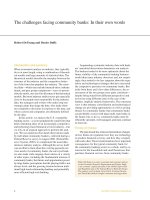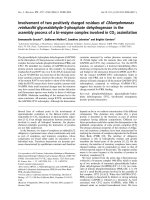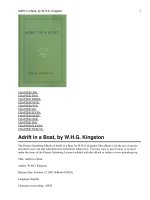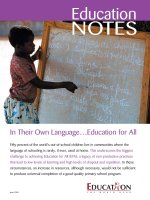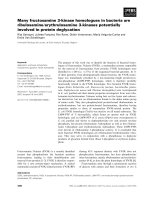3 theyre there in their boat
Bạn đang xem bản rút gọn của tài liệu. Xem và tải ngay bản đầy đủ của tài liệu tại đây (1.18 MB, 25 trang )
Mary Elizabeth Salzmann
They’re
There in
Their Boat
Mary Elizabeth Salzmann
Published by SandCastle™, an imprint of ABDO Publishing Company, 4940 Viking Drive, Edina,
Minnesota 55435.
Copyright © 2002 by Abdo Consulting Group, Inc. International copyrights reserved in all
countries. No part of this book may be reproduced in any form without written permission
from the publisher. SandCastle™ is a trademark and logo of ABDO Publishing Company.
Printed in the United States.
Cover and interior photo credits: Artville, Digital Stock, Eyewire Images, PhotoDisc, Stockbyte
Library of Congress Cataloging-in-Publication Data
Salzmann, Mary Elizabeth, 1968They’re there in their boat / Mary Elizabeth Salzmann.
p. cm. -- (Homophones)
Includes index.
Summary: Photographs and simple text introduce homophones, words that sound alike
but are spelled differently and have different meanings.
ISBN 1-57765-650-4
1. English language--Homonyms--Juvenile literature. [1. English language--Homonyms.]
I. Title. II. Series.
PE1595 .S27 2002
428.1--dc21
2001053306
The SandCastle concept, content, and reading method have
been reviewed and approved by a national advisory board
including literacy specialists, librarians, elementary school
teachers, early childhood education professionals, and parents.
Let Us Know
After reading the book, SandCastle would like you to tell us your
stories about reading. What is your favorite page? Was there something
hard that you needed help with? Share the ups and downs of learning
to read. We want to hear from you! To get posted on the ABDO
Publishing Company Web site, send us email at:
About SandCastle
™
Nonfiction books for the beginning reader
9 Basic concepts of phonics are incorporated with integrated language methods
of reading instruction. Most words are short, and phrases, letter sounds, and
word sounds are repeated.
9 Book levels are based on the ATOS™ for Books formula. Other considerations
for readability include the number of words in each sentence, the number of
characters in each word, and word lists based on curriculum frameworks.
9 Full-color photography reinforces word meanings and concepts.
9 “Words I Can Read” list at the end of each book teaches basic elements of
grammar, helps the reader recognize the words in the text, and builds vocabulary.
9 Reading levels are indicated by the number of flags on the castle.
SandCastle uses the following definitions for this series:
9 Homographs: words that are spelled the same but sound different and have
different meanings. Easy memory tip: “-graph”= same look
9 Homonyms: words that are spelled and sound the same but have different
meanings. Easy memory tip: “-nym”= same name
9 Homophones: words that sound alike but are spelled differently and have
different meanings. Easy memory tip: “-phone”= sound alike
Look for more SandCastle books in these three reading levels:
Level 1
(one flag)
Level 2
(two flags)
Level 3
(three flags)
Grades Pre-K to K
Grades K to 1
Grades 1 to 2
5 or fewer words per page
5 to 10 words per page
10 to 15 words per page
Homophones
they’re
there
their
they are
that place
or
a pronoun
belonging
to them
4
Homophones
Homophones are words that
sound alike but are spelled
differently and have different
meanings.
5
Homophones
Gabe and Aaron love ice cream.
Vanilla is their favorite kind.
6
Homophones
Garen and Earl are brothers.
They’re playing in their front
yard.
7
Homophones
We have fun at the beach.
We run from here to there.
8
Homophones
There are puppies sniffing
my face.
They make me giggle.
9
Homophones
Ray and his grandpa play a
game on their computer.
10
Homophones
They’re making a lot of cookies
for the school bake sale.
11
Homophones
There are two girls playing on
the tire swing.
They are sisters.
12
Homophones
They have fun on Halloween.
They’re wearing their costumes
to a party.
13
Homophones
Jackie runs to second base.
She hopes she will get there
safely.
14
Homophones
Marsha and Nancy read
together.
Their book is very funny.
15
Homophones
They’re blowing out birthday
candles.
It is a fun party.
16
Homophones
They’re going to school.
They get there on the bus.
17
Homophones
Ned and Quint lie in their
hammock and eat their apples.
18
Homophones
They’re riding a paddleboat on
the lake.
Larry waves to his mom.
19
Homophones
Dale finds Chicago on
the globe.
His grandma lives there.
20
Homophones
These kids are in the back seat.
Who is in the front seat?
(their dad)
21
Words I Can Read
Nouns
A noun is a person, place, or thing
apples (AP-uhlz) p. 18
bake sale
(BAYK SAYL) p. 11
base (BAYSS) p. 14
beach (BEECH) p. 8
birthday (BURTH-day)
p. 16
book (BUK) p. 15
brothers (BRUHTH-urz)
p. 7
bus (BUHSS) p. 17
candles (KAN-duhlz)
p. 16
game (GAME) p. 10
girls (GURLZ) p. 12
globe (GLOHB) p. 20
grandma
(GRAND-mah) p. 20
grandpa
(GRAND-pah) p. 10
hammock (HAM-uhk)
p. 18
paddleboat
(PAD-uhl-bote) p. 19
party (PAR-tee)
pp. 13, 16
place (PLAYSS) p. 4
pronoun (PROH-noun)
p. 4
puppies (PUHP-eez)
p. 9
here (HIHR) p. 8
homophones
(HOME-uh-fonez)
p. 5
computer
(kuhm-PYOO-tur)
ice cream
(EYESS KREEM) p. 6
p. 10
kids (KIDZ) p. 21
cookies (KUK-eez) p. 11 kind (KINDE) p. 6
costumes
lake (LAKE) p. 19
(KOSS-toomz) p. 13
lot (LOT) p. 11
dad (DAD) p. 21
meanings (MEE-ningz)
face (FAYSS) p. 9
p. 5
fun (FUHN) pp. 8, 13
mom (MOM) p. 19
22
school (SKOOL)
pp. 11, 17
seat (SEET) p. 21
sisters (SISS-turz) p. 12
swing (SWING) p. 12
there (THAIR) pp. 4, 8
tire (TIRE) p. 12
vanilla (vuh-NIL-uh)
p. 6
words (WURDZ) p. 5
yard (YARD) p. 7
Proper Nouns
A proper noun is the name of a person, place, or thing
Aaron (AIR-ruhn) p. 6
Garen (GAHR-uhn) p. 7
Chicago (shi-KAH-goh) Halloween
p. 20
(hal-oh-EEN) p. 13
Dale (DAYL) p. 20
Jackie (JAK-ee) p. 14
Earl (URL) p. 7
Larry (LAIR-ee) p. 19
Gabe (GAYB) p. 6
Marsha (MARSH-uh)
p. 15
Nancy (NAN-see) p. 15
Ned (NED) p. 18
Quint (KWINT) p. 18
Ray (RAY) p. 10
Pronouns
A pronoun is a word that replaces a noun
it (IT) p. 16
me (MEE) p. 9
she (SHEE) p. 14
there (THAIR)
pp. 4, 9, 12
them (THEM) p. 4
they (THAY)
pp. 4, 9, 12, 13, 17
we (WEE) p. 8
who (HOO) p. 21
Verbs
A verb is an action or being word
are (AR)
pp. 4, 5, 7, 9, 12, 21
belonging
(bi-LONG-ing) p. 4
blowing (BLOH-ing)
p. 16
eat (EET) p. 18
finds (FINDEZ) p. 20
get (GET) pp. 14, 17
giggle (GIG-uhl) p. 9
going (GOH-ing) p. 17
have (HAV) pp. 5, 8, 13
hopes (HOPESS) p. 14
is (IZ) pp. 6, 15, 16, 21
lie (LYE) p. 18
lives (LIVZ) p. 20
love (LUHV) p. 6
make (MAKE) p. 9
making (MAKE-ing)
p. 11
play (PLAY) p. 10
playing (PLAY-ing)
pp. 7, 12
read (REED) p. 15
23
riding (RIDE-ing) p. 19
run (RUHN) p. 8
runs (RUHNZ) p. 14
sniffing (SNIF-ing) p. 9
sound (SOUND) p. 5
spelled (SPELD) p. 5
waves (WAYVZ) p. 19
wearing (WAIR-ing)
p. 13
will (WIL) p. 14
Adjectives
An adjective describes something
alike (uh-LIKE) p. 5
back (BAK) p. 21
different (DIF-ur-uhnt)
p. 5
favorite (FAY-vuh-rit)
p. 6
front (FRUHNT)
pp. 7, 21
fun (FUHN) p. 16
funny (FUH-nee) p. 15
his (HIZ) pp. 10, 19, 20
my (MYE) p. 9
second (SEK-uhnd)
p. 14
that (THAT) p. 4
their (THAIR) pp. 4, 6, 7,
10, 13, 15, 18, 21
these (THEEZ) p. 21
two (TOO) p. 12
Adverbs
An adverb tells how, when, or where something happens
differently
(DIF-ur-uhnt-lee) p. 5
out (OUT) p. 16
safely (SAYF-lee) p. 14
there (THAIR)
pp. 14, 17, 20
together
(tuh-GETH-ur) p. 15
very (VER-ee) p. 15
Contractions
A contraction is two words combined with an apostrophe
they’re (THAIR) pp. 4,
7, 11, 13, 16, 17, 19
24


